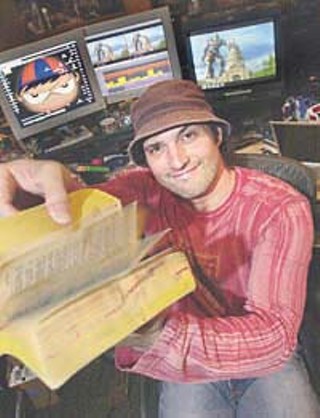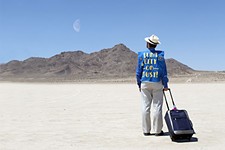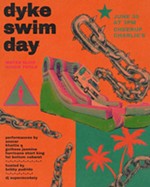Comin' at Ya!
3-D is back on the big screen -- again
By Ken Lieck, Fri., July 25, 2003

It's a safe bet that awestruck audiences of the 1850s and 1860s, paying their pennies to see stereoscopic views shown through a Magic Lantern, couldn't have possibly imagined that nearly 150 years later people would be lining up to see Robert Rodriguez's Spy Kids 3-D: Game Over through lenses patterned directly after the ones being used in their Civil War-era slide shows.
But those awestruck audiences weren't watching Rodriguez's adventurous Cortez family speed-surf through hot lava with Juni or duck out of the path of bouncing pogo-stick-riding toad-men, and they weren't cringing as a Beta Tester's laser-staff came a little too close to their theatre seat. Those awestruck audiences were quite possibly marveling at an inert -- albeit a roughly three-dimensional -- barrel while sitting on an inert, three-dimensional barrel.
It wasn't until the mid-19th century, when photographers began experimenting with the so-called "anaglyph" process, that 3-D viewing as we now know it was born. Anaglyph 3-D centered around the wearing of glasses with red and blue lenses to achieve what is called subtractive filtration. This allowed each eye to "pull" different views out of a pair of images that were being projected simultaneously, thus leaving the brain to combine them into a stereoscopic image, just as it did with the real world. The illusion, that is, of the real world. Or, the illusion of depth.
Even so, it wasn't until the mid-20th century that 3-D motion was introduced to a wide audience with the release and success of Bwana Devil in 1952. The Hollywood 3-D craze that film introduced was over in three years, and despite the occasional sputter, there hasn't been much use of the form since.

True fans of 3-D, though, dream of the day when stereo visuals proudly return to prominence at their local movie theatre, this time to stay. Fortunately, it would appear that there are some who possess the capability to bring those dreams to reality. The Reality Camera System, developed by underwater-camera designer Vince Pace (www.pacetech.com) and Titanic director James Cameron, was thus named because its lenses can converge just like the human eyes do, thus reducing the occurrence of eyestrain. Commissioned and built for the 3-D documentary Ghosts of the Abyss, the RCS combines two Sony high-definition HD 24P cameras into a single unit, incorporating a motion controller to provide simultaneous control for both lenses and on-camera convergence.
Although Ghosts was made to be screened using polarized lenses, movies made with the camera aren't limited to that format. Indeed, Rodriguez realized immediately that the RCS (and with it, the aid of camera-wrangler extraordinaire Pace) was precisely what he was looking for in order to realize his own dream of shooting the third Spy Kids movie in 3-D, giving him "all the options," as he puts it. He counts it as a major boon that film shot with the RCS can be used in IMAX theatres and theme parks with polarized glasses, in theatres with anaglyph, or even on a flat television screen without the 3-D altogether. However, as is typical with anaglyph 3-D, the movie's gorgeous blend of animation and live action is marred by the overpowering tints of the 3-D lenses.
Fortunately, the RCS put Rodriguez at an advantage over previous 3-D filmmakers by being monitor-friendly. At his Austin studio, a 3-foot-by-4-foot HDTV projection screen allowed him to check out ahead of time what audiences would be seeing, which allowed him to at least make attempts at countering for the color bombardment.
Ghosts was shown primarily at IMAX theatres, and to screen it in areas without an IMAX, theatres were refitted with reflective silver screens and special projection lenses. Rodriguez's film, however, was always intended for a far wider audience, and when Spy Kids 3-D opens at 3,500 theatres nationwide on Friday, friendly ushers will be handing each theatre patron a pair of red/blue-lensed anaglyph glasses. That's because theatres don't have to install special projection equipment or screens to run the film in anaglyph 3-D. The only difference between running SK3-D and any other summer blockbuster will be hanging on your ears.
Renowned 3-D artist/historian Ray Zone (www.ray3dzone.com), who specially designed the 3-D glasses for SK3-D to match those worn by the film's stars, says the question of Polaroid versus anaglyph is moot. Using a polarized setup isn't feasible for a movie in wide release, he explains, because it would have cost too much money if that many theatres were to install custom projection equipment and silver screens. In addition, he says, using anaglyph simplifies cross-promoting the film. "The same inexpensive paper glasses used for the 3-D comics and toys at McDonald's can also be used to view the film," points out Zone, and he should know -- he happens to have designed SK3-D's promotional freebies, as well.

The first few years of the 20th century saw many attempts to perfect the idea of combining 3-D with the new "moving picture" phenomenon, but the first public exhibition of a 3-D film in America didn't come until 1915. Color 3-D movies became possible when the Thirties brought a new process using Polaroid lenses. Polarized lenses also filtered images separately into the left and right eyes like anaglyphs, but Polaroids had a distinct advantage over the red-and-blue lenses. Watching stereoscopic movies with anaglyph, audiences were forced to accept the annoying color bombardment created by the tint of the lenses, but the clear polarized lenses presented no such problem. Still, despite a couple of experiments with the form (more in Europe than in the States) 3-D remained a marginalized novelty.
By 1952, Hollywood was experiencing a meltdown. The Paramount decision of 1948 had forced them to sell off their theatre chains, wrecking the bottom line, and the big movie moguls were running about in a tizzy over the increasing popularity of television, which threatened their very existence by keeping people at home and out of the theatres. The theatrical experience had to offer something that TV didn't. Cinerama was introduced in late 1951/early 1952 but the equipment involved restricted exhibition possibilities. Legendary radio master Arch Oboler had just turned his attention to film when he saw a test of a new 3-D process. Always a fan of the gimmick, he was quick to see the potential. Bwana Devil, a low-budget jungle picture with nothing to recommend it -- except the fact that it was shot in 3-D -- was soon released. The movie was a huge smash, but Oboler's polarized 3-D system, Natural Vision, had problems. For instance, if the projectionist didn't get everything just perfect, the audience would see nothing but an indecipherable blur onscreen.
Still, the arrival of a full-blown 3-D fad was merely a matter of time. While many think of 1950s 3-D as cheap horror and action fare, the truth is that alongside House of Wax and It Came From Outer Space, classics like Hitchcock's Dial M for Murder and John Wayne's Hondo were also shot and shown in 3-D. So was Dean Martin and Jerry Lewis' Money From Home, the lavish musical Kiss Me Kate, and the noir classic I, the Jury. Not all films milked the novelty aspect of throwing various objects at the audience, either; some directors excelled at utilizing 3-D to create an atmosphere within their films that "flat" pictures couldn't convey. In some cases, it's hard to imagine why the film was shot in 3-D except to cash in on the craze (catch Dial M for Murder in 3-D sometime).
Hollywood unnerved has never been a pretty thing, and it overexploited the trend until it wore the audience out. In the face of competition by cheaper more substantial innovations like Cinemascope (followed by a host of other wide-screen processes) and a glut of 3-D comic books and other print novelties, within two years the craze had completely run its course. The next quarter-century succeeded only in making 3-D synonymous with "desperate" and "pathetic." There were two mercifully brief flurries of 3-D releases, one in the early Seventies in the wake of The Stewardesses, a soft-core mess, and a decade later in the wake of the Z-grade flaccid Italian 3-D Western, Comin' at Ya! Outside of those, there were only unnecessary sequels to flagging franchises: Amityville 3-D, Jaws 3-D, Friday the 13th Part 3: 3-D.

In the late 1980s, 3-D was thrown a lifeline by the nation's theme parks. With 1986's Captain EO, producer George Lucas and director Francis Ford Coppola raised the bar on 3-D by remaking it as a must-see attraction, adding state-of-the-art sound, lighting, and temperature effects. Today, Universal Studios and Disney parks continue attempting to top each other with stereoscopic extravaganzas like Universal's Terminator 2: 3D Battle Across Time, which utilizes a nearly IMAX-sized silver screen, smoke and lighting effects, animatronic characters, a small army of live, costumed humans, and a budget comparable to that of its cinema-bound cousins. Beats the hell out of a Magic Lantern.
Spy Kids 3-D is arguably the best 3-D theatrical release ever. The film makes use of the extra dimension by incorporating it as part of the film and not simply a gimmick resorted to in shock moments. With an explosion of color, movement, and action, Rodriguez seems to have even more fun cramming the film with visual ideas and textured moments than audiences will have watching it. The question many have leaving the theatre, besides when is the next show, is how will this play when released for home viewing?
Just as videotape and now DVD have brought the movies from the theatres into our living rooms, the idea of 3-D viewing at home is starting to reach its potential. The first American TV broadcast in 3-D aired to scattered interest back in 1980, and the networks have rarely troubled themselves with it since, but improvements to television itself, from larger screens to high definition, are nowadays making the tube far more compatible with the various 3-D processes. As for Spy Kids 3-D, Zone believes that it will "undoubtedly" use anaglyph when it is issued on DVD, as "there really is no viable polarizing 3-D process available for home use on televisions at this time."
Then again, anaglyph and polarized may not be Rodriguez's only options. A 3-D system out now from Slingshot Entertainment (www.slingshotent.com) uses yet another viewing system, the Liquid Crystal Shutter. LCS glasses, which are also currently popular among computer gamers, work by electronically syncing up to the images on your TV, alternately opening and shutting at hummingbird-wing speed to bring the two eyes' visions together into a single three-dimensional one. Mitch Perliss, general manager of Slingshot, says that the best thing looming in 3-D's near future might be its past. Older stereoscopic films can now be affordably and professionally adapted to be shown using newer 3-D processes, so it's only a matter of time before they start becoming available. To date, the sole "classic" 3-D movie Slingshot has issued on DVD is the 1967 Monster From a Prehistoric Planet. "We're working with the major studios right now to bring the classic Fifties and later [3-D] films to DVD," he assures, adding that "there's a few things already happening."
While Perliss waits for Hondo and Dial M for Murder, Slingshot has begun issuing public domain features like Night of the Living Dead and Radar Men From the Moon in "zDVD," a process that turns 2-D films into 3-D ones. "The zDVD technology doesn't really work as 3-D yet," warns Zone, but some should find it worth a look. Even more tantalizing is Razor 3D's (www.razor3d.com) new Virtual FX 2D to 3D Converter system, due in August, which claims to "perform complicated mathematical algorithms which convert standard 2D video into Real 3D." Holography continues to grow out of its infancy as well. And Zone says that there are now autostereoscopic (glasses-free) systems for 3-D TV on the market. "Some of them use lenticular sheets or barrier grids, and others use holographic plates," he explains, "[and] they work very well if you don't move too much during viewing!"
There's no way to predict if and when 3-D will become standard among our entertainment fodder -- at least not until the box-office reports on Spy Kids 3-D start coming in. But even now, while thrilling to the ride Rodriguez provides in theatres, imagine how much fun this will be watching over and over again at home. ![]()










